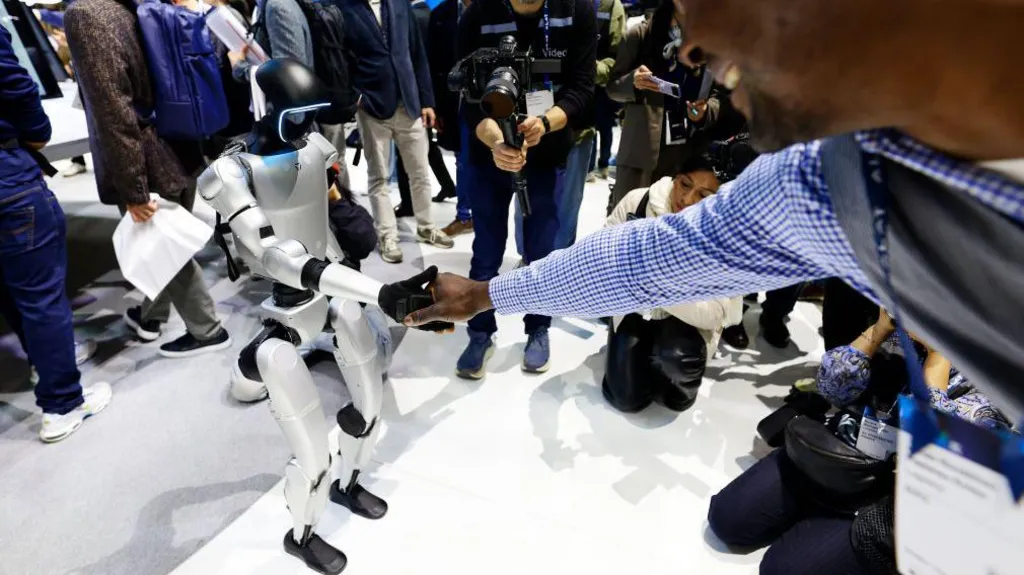
It’s a bright spring morning in Hanover, Germany, and I’m on my way to meet a robot.
I have been invited to see the G1, a humanoid robot built by Chinese firm, Unitree, at the Hannover Messe, one of the world’s largest industrial trade shows.
Standing at about 4’3″ (130cm), G1 is smaller and more affordable than other humanoid robots on the market, and has such a highly fluid range of motion and dexterity that videos of it performing dance numbers and martial arts have gone viral.
Today the G1 is being controlled remotely by Pedro Zheng, the Unitree sales manager.
He explains that customers must program each G1 for autonomous functions.
Passers-by stop and actively try to engage with the G1, which cannot be said for a lot of the other machines being shown off in the cavernous conference room.
They reach out to shake its hand, make sudden movements to see if it will respond, they laugh when G1 waves or bends backwards, they apologise if they bump into it. There’s something about its human shape that, uncanny as it is, sets people at ease.
Unitree is just one of dozens of companies around the world developing robots that have a human form.
The potential is huge – for business it promises a workforce that doesn’t need holidays or pay rises.
It could also be the ultimate domestic appliance. After all, who wouldn’t want a machine that could do the laundry and stack the dishwasher.
But the technology is still some way off. While robotic arms and mobile robots have been common in factories and warehouses for decades, conditions in those workplaces can be controlled and workers can be kept safe.
Introducing a humanoid robot to a less predictable environment, like a restaurant or a home, is a much more difficult problem.
To be useful humanoid robots would have to be strong, but that also makes them potentially dangerous – simply falling over at the wrong time could be hazardous.
So much work needs to be done on the artificial intelligence that would control such a machine.
“The AI simply has not yet reached a breakthrough moment,” a Unitree spokesperson tells the BBC.
“Today’s robot AI finds basic logic and reasoning – such as for understanding and completing complex tasks in a logical way – a challenge,” they said.
At the moment their G1 is marketed at research institutions and tech companies, who can use Unitree’s open source software for development.
For now entrepreneurs are focussing their efforts on humanoid robots for warehouses and factories.
The highest profile of those is Elon Musk. His car company, Tesla, is developing a humanoid robot called Optimus. In January he said that “several thousand” will be built this year and he expects them to be doing “useful things” in Tesla factories.
Other carmakers are following a similar path. BMW recently introduced humanoid robots to a US factory. Meanwhile, South Korean car firm Hyundai has ordered tens of thousands of robots from Boston Dynamics, the robot firm it bought in 2021.
Thomas Andersson, founder of research firm STIQ, tracks 49 companies developing humanoid robots – those with two arms and legs. If you broaden the definition to robots with two arms, but propel themselves on wheels, then he looks at more than 100 firms.
Mr Andersson thinks that Chinese companies are likely to dominate the market.
“The supply chain and the entire ecosystem for robotics is huge in China, and it’s really easy to iterate developments and do R&D [research and development],” he says.
Unitree underlines that advantage – its G1 is cheap (for a robot) with an advertised price of $16,000 (£12,500).
Also, Mr Andersson points out, the investment favours Asian nations.
In a recent report STIQ notes that almost 60% of all funding for humanoid robots has been raised in Asia, with the US attracting most of the rest.
Chinese companies have the added benefit of support from the national and local government.
For example, in Shanghai there is a state-backed training facility for robots, where dozens of humanoid robots are learning to complete tasks.


